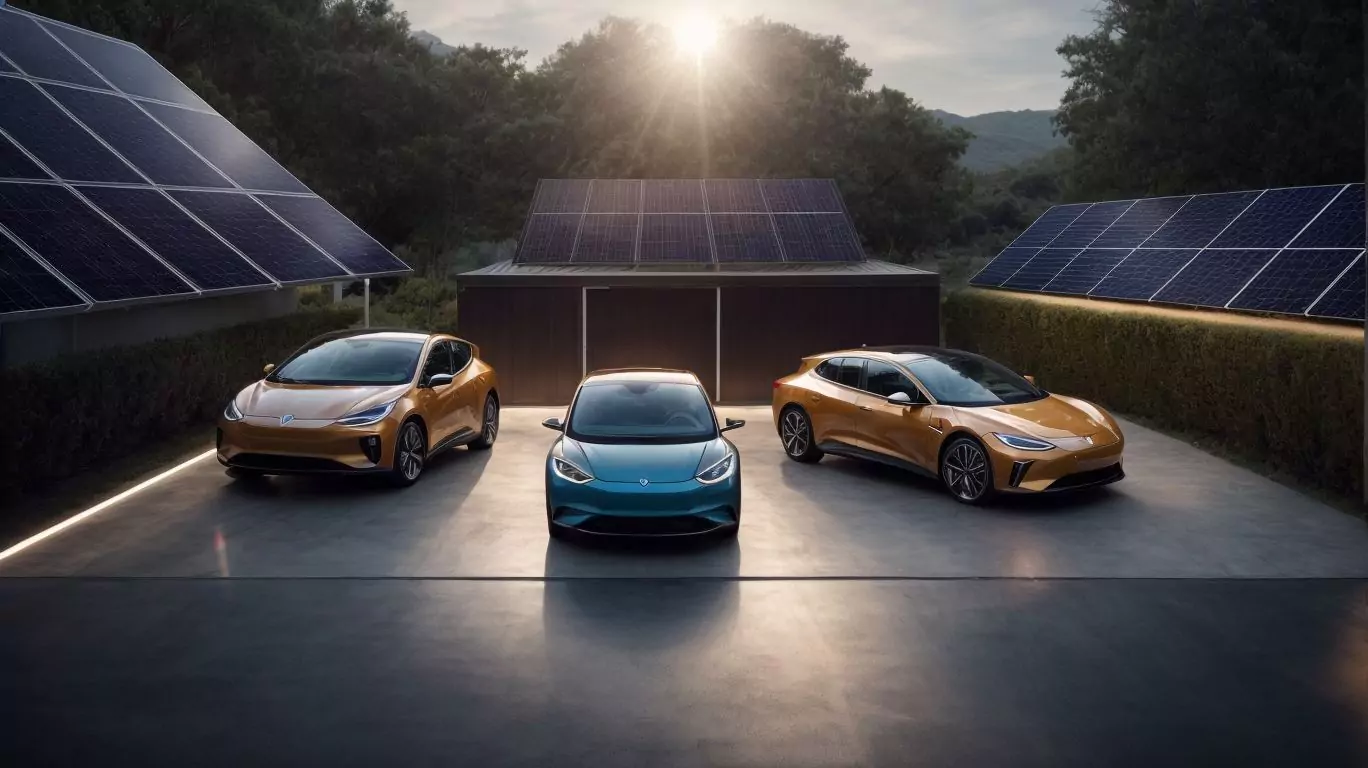Solar Power and Electric Cars: A Sustainable Partnership for Clean Energy

As global climate concerns continue to rise, the demand for sustainable energy sources is more pressing than ever. If you’re someone who is looking for eco-friendly solutions for your energy and transportation needs, then this article is for you. Let’s explore the partnership between solar power and electric cars, and how it can play a crucial role in creating a better, cleaner future.
What Is Solar Power?
Solar power refers to the use of sunlight to generate electricity. It is a sustainable and renewable source of energy that harnesses the power of the sun. The process involves the use of solar panels, which are typically made up of photovoltaic cells that convert sunlight into usable electricity.
Solar power has several advantages. Firstly, it is a clean and environmentally friendly source of energy, emitting no greenhouse gases or air pollutants during operation. Secondly, it is abundant and readily available, making it a cost-effective solution in the long run. Additionally, solar power systems can be easily installed on rooftops or in open spaces, making them versatile and accessible for both residential and commercial use.
The utilization of solar power can help reduce dependence on fossil fuels, mitigate climate change, and promote energy independence. With advancements in technology, solar power is becoming more efficient and affordable, making it a viable option for powering electric cars, homes, and businesses.
What Are the Different Types of Solar Power Systems?
When it comes to harnessing the power of the sun, there are various types of solar power systems to choose from. Each system has its own unique features and benefits. In this section, we will explore the different types of solar power systems available and how they differ from one another. From grid-tied systems that connect to the traditional power grid, to off-grid systems that operate independently, and even hybrid systems that combine the best of both worlds – get ready to discover the diverse world of solar power.
1. Grid-Tied Solar Power Systems
Grid-tied solar power systems are connected to the local electric grid, allowing homeowners to utilize solar energy while still having access to traditional electricity. Here are the essential steps involved in setting up a grid-tied solar power system:
- Assess your energy needs: Determine your average electricity consumption to properly size the solar system.
- Research local regulations: Check for any necessary permits and regulations required for installing solar panels and connecting to the grid.
- Select a solar installer: Find a reputable solar installation company to design and install the system.
- Site evaluation: The installer will evaluate your location to determine the best positioning for optimal sunlight exposure.
- System design: The installer will design a system that meets your energy needs, taking into account factors such as panel placement and inverter selection.
- Installation: The solar panels, inverters, and other equipment will be installed on your property, typically on the roof.
- Interconnection: The installer will connect your solar system to the grid, ensuring it meets all safety and regulatory requirements.
- Net metering setup: Arrange for net metering with your utility company, which credits you for any excess energy your system produces.
- System activation: Once everything is in place, your solar system can be activated, allowing you to benefit from solar energy while still having grid backup.
2. Off-Grid Solar Power Systems
Off-grid solar power systems are an excellent alternative when access to the electrical grid is limited or unavailable. These systems allow individuals or communities to generate their own electricity independently.
Here are the steps involved in setting up an off-grid solar power system:
- Assess energy needs: Determine the amount of electricity required based on daily usage and appliances.
- Design the system: Select the appropriate solar panels, inverters, batteries, and charge controllers based on energy needs and location.
- Install solar panels: Position the panels in an optimal location to receive maximum sunlight throughout the day.
- Install the battery bank: Connect the batteries to the solar panels and inverters to store excess energy for use when the sun is not shining.
- Install the inverter: Connect the inverter to the battery bank and electrical system to convert DC power from the batteries to AC power for household use.
- Connect to appliances: Connect the inverter to the electrical system of the house to power appliances and devices.
- Maintain the system: Regularly monitor the system, clean the solar panels, and maintain the batteries to ensure optimal performance.
Off-grid solar power systems offer energy independence and the ability to live sustainably. They are particularly beneficial in remote areas where extending the electrical grid is costly or impractical. By harnessing the power of the sun, these systems provide a reliable and environmentally friendly source of electricity.
3. Hybrid Solar Power Systems
Hybrid solar power systems combine the best of both grid-tied and off-grid systems, offering flexibility and reliability. Here are the steps involved in setting up a hybrid solar power system:
- Install solar panels on your property to generate electricity from the sun.
- Connect the solar panels to an inverter, which converts the DC power generated by the panels into AC power used in your home.
- Install a battery bank to store excess energy generated during the day for use during the night or during power outages.
- Connect the inverter to a charge controller, which regulates the flow of electricity between the solar panels, batteries, and the grid.
- Connect the hybrid system to the electrical grid to allow for the use of grid power when needed and to sell excess solar power back to the grid.
Hybrid solar power systems offer the advantage of increased self-sufficiency, as they can provide electricity even during grid outages. They also allow homeowners to take advantage of net metering programs, which can reduce or eliminate electricity bills. Consider consulting with a professional solar installer to determine if a hybrid solar power system is suitable for your needs.
How Does Solar Power Work?
Solar power is a sustainable and renewable energy source that has gained popularity in recent years. Understanding how solar power works can help us appreciate its benefits and potential for a greener future.
Here is a step-by-step breakdown of how solar power works:
- Sunlight hits the solar panels installed on rooftops or in open spaces.
- The panels are made up of photovoltaic cells that absorb the sunlight.
- The absorbed sunlight excites the electrons in the cells, creating an electric current.
- The direct current (DC) electricity produced by the panels is then converted into alternating current (AC) electricity using an inverter.
- This AC electricity can now be used to power homes, businesses, or electric vehicles.
- Excess electricity produced can be stored in batteries for use during cloudy days or at night.
- Any surplus electricity can be fed back into the grid, earning credits or compensation.
To understand the workings of solar power and reap its benefits, consider the following suggestions:
- Install solar panels on your property to generate clean energy for your home or business.
- Invest in energy-efficient appliances and lighting to make the most of solar power.
- Consider purchasing an electric vehicle to further reduce reliance on fossil fuels.
- Explore government incentives and tax credits that can help offset the cost of solar installations.
- Educate others about the advantages of solar power and encourage them to make sustainable choices.
What Are the Benefits of Solar Power?
Solar power has become increasingly popular as a renewable and sustainable energy source. In this section, we will delve into the numerous benefits of utilizing solar power. From its cost-effectiveness to its positive impact on the environment, we will explore how solar power can benefit both individuals and the planet. By the end of this section, you will have a deeper understanding of why solar power is a crucial component of a sustainable future.
1. Renewable and Sustainable
Solar power is an energy source that is both renewable and sustainable, providing numerous benefits. To gain a better understanding of this concept, follow these steps:
- Solar panels, composed of photovoltaic cells, capture sunlight.
- The cells convert the sunlight into direct current (DC) electricity.
- An inverter then transforms the DC electricity into alternating current (AC) electricity, which can be used in homes and businesses.
- The AC electricity powers various appliances and devices, reducing the dependence on traditional power sources.
- Excess electricity generated by the solar panels can be stored in batteries for later use or fed back into the grid.
- By utilizing solar power, reliance on non-renewable energy sources is decreased, promoting a more sustainable and greener future.
Solar power not only benefits the environment, but it also helps to lower electricity bills and reduce carbon emissions. Incorporating solar power into our daily lives is an effective way to support a renewable and sustainable future.
2. Cost-Effective
Solar power is not only a sustainable and renewable energy source but also a cost-effective solution for powering homes and businesses. Here are some steps to consider when assessing the cost-effectiveness of solar power:
- Calculate the initial investment: Determine the cost of installing a solar power system by considering the size of the system, equipment costs, and installation fees.
- Estimate long-term savings: Solar power systems can significantly reduce electricity bills. Calculate the potential savings over the system’s lifespan, taking into account the current and projected electricity rates.
- Consider financial incentives: Research government incentives and rebates for installing solar panels. These incentives can help offset the initial investment and make solar power more cost-effective.
- Assess maintenance and operational costs: Solar panels require minimal maintenance, reducing long-term costs. However, consider factors like cleaning, repairs, and system monitoring.
- Evaluate the payback period: Determine the amount of time it takes to recoup the initial investment through energy savings. A shorter payback period indicates higher cost-effectiveness.
By considering these steps, individuals and businesses can make an informed decision about investing in cost-effective solar power systems.
3. Reduces Carbon Footprint
One of the key benefits of solar power is its ability to reduce carbon footprint. By harnessing energy from the sun, solar power systems produce electricity without emitting greenhouse gases or other harmful pollutants. Here are some steps to illustrate how solar power reduces carbon footprint:
- Generation of clean energy: Solar panels convert sunlight into electricity through the photovoltaic effect, producing clean and renewable energy.
- Replacement of fossil fuels: Solar power reduces the need for electricity generated from fossil fuels such as coal or natural gas, which release carbon dioxide when burned.
- Lower carbon emissions: By relying on solar power, carbon emissions associated with traditional energy sources are significantly reduced, helping combat climate change.
- Positive environmental impact: Solar energy contributes to cleaner air and water, reduces reliance on finite resources, and helps preserve ecosystems.
Incorporating solar power into various sectors, including transportation with electric cars, further accelerates the reduction of carbon footprint and promotes a sustainable future.
What Are Electric Cars?
Electric cars, also known as electric vehicles (EVs), are automobiles that are powered by electricity rather than gasoline or diesel fuel. They utilize one or more electric motors for propulsion, drawing energy from rechargeable batteries. EVs have gained popularity in recent years due to their numerous benefits.
Firstly, they are environmentally friendly, emitting zero tailpipe emissions and reducing air pollution. Additionally, electric cars are more energy-efficient than traditional internal combustion engine vehicles, converting a higher percentage of stored energy into actual motion. They also offer a smoother and quieter ride compared to conventional vehicles. Furthermore, EVs can potentially save drivers money on fuel costs and maintenance expenses. Although electric cars typically have a higher upfront cost, they usually have lower operating costs in the long run.
In summary, electric cars are a promising alternative to traditional vehicles, providing a sustainable and efficient mode of transportation. Did you know that electric cars have been around since the 1830s? The first fully electric car was developed by Scottish inventor Robert Anderson.
How Do Electric Cars Work?
Electric cars operate using electricity instead of gasoline, making them an environmentally friendly and sustainable option. Here is a step-by-step breakdown of their functioning:
- Battery storage: Electric cars have a large battery pack that stores electricity. The battery is rechargeable and provides the necessary energy to power the car.
- Electric motor: The electric motor converts electrical energy from the battery into mechanical energy, propelling the car forward.
- Charging: Electric cars require charging to replenish the energy in the battery. This can be done by plugging the car into a charging station or using a home charging unit.
- Regenerative braking: Electric cars utilize regenerative braking, which captures the energy produced during braking and converts it into electricity to recharge the battery.
- Controller: The controller serves as the brain of the electric car, managing the flow of electricity from the battery to the motor and controlling the car’s speed.
Overall, electric cars offer a clean and sustainable alternative to traditional gasoline-powered vehicles, reducing greenhouse gas emissions and reducing reliance on fossil fuels. They play a crucial role in transitioning to a more sustainable transportation system.
What Are the Benefits of Electric Cars?
As electric cars continue to gain popularity and become more accessible, it is important to understand the numerous benefits they offer. In this section, we will explore the advantages of electric cars, including their zero emissions, lower operating costs, and reduced dependence on fossil fuels. By delving into these benefits, we can gain a better understanding of how electric cars are paving the way for a more sustainable future.
1. Zero Emissions
Electric cars offer several benefits, one of which is their contribution to zero emissions. By utilizing electric motors and batteries instead of internal combustion engines, electric cars produce no tailpipe emissions, helping to reduce air pollution and combat climate change. Here are some steps to understand the concept and importance of zero emissions in electric cars:
- Electric motors: Electric cars use electric motors powered by rechargeable batteries instead of burning fossil fuels, resulting in zero tailpipe emissions.
- Energy source: The environmental impact of an electric car depends on the source of the electricity used to charge it. Renewable energy sources like solar power can provide emission-free charging.
- Reduced pollution: Zero emissions from electric cars means less pollution, improving air quality and reducing health risks associated with traditional vehicles.
- Climate change mitigation: By reducing greenhouse gas emissions, electric cars play a role in combating climate change and achieving sustainability goals.
- Long-term benefits: The transition to electric cars can lead to long-term benefits, such as reduced dependence on fossil fuels, energy independence, and a more sustainable transportation system.
Overall, the concept of zero emissions in electric cars contributes to a cleaner and greener future for transportation.
2. Lower Operating Costs
Electric cars offer several benefits, including lower operating costs. To understand how electric cars can save you money, here are a few steps to follow:
- Lower fuel costs: Electric cars are powered by electricity, which is typically cheaper than gasoline or diesel fuel. Charging an electric car can cost significantly less than refueling a conventional vehicle.
- Reduced maintenance expenses: Electric cars have fewer moving parts compared to internal combustion engine vehicles, resulting in lower maintenance costs over time. This eliminates the need for oil changes, spark plug replacements, or transmission maintenance.
- Tax incentives and rebates: Many governments and local authorities offer tax incentives, rebates, or grants for purchasing electric vehicles. These financial incentives can help offset the initial higher purchase price.
- Longer-lasting brakes: Electric cars use regenerative braking, which helps recharge the battery while slowing down. This reduces wear and tear on the brake pads, resulting in longer-lasting brakes and lower maintenance costs.
By considering these factors, you can take advantage of the lower operating costs of electric cars and save money in the long run. Additionally, be sure to compare electricity rates and charging options in your area to make the most efficient use of your electric vehicle.
3. Reduced Dependence on Fossil Fuels
Reducing our dependence on fossil fuels is a crucial benefit of electric cars. Here are the steps to understand how electric cars contribute to this goal:
- Electric cars run on electricity stored in batteries, eliminating the need for gasoline or diesel fuel.
- Instead of using internal combustion engines that rely on fossil fuels, electric cars use electric motors powered by rechargeable batteries.
- By charging electric cars with renewable energy sources like solar power, the reliance on fossil fuels for electricity generation is reduced.
- As the demand for electric cars increases, there is a corresponding decrease in the demand for gasoline and diesel, leading to a reduced dependence on fossil fuels.
Fact: By 2030, it is estimated that around 30% of the global vehicle fleet will be electric, further reducing our dependence on fossil fuels.
How Do Solar Power and Electric Cars Work Together?
As the world moves towards more sustainable forms of energy, solar power and electric cars have become increasingly popular. But did you know that these two technologies can also work together to create an even more sustainable partnership? In this section, we will delve into the ways in which solar power and electric cars can work hand in hand. From using solar energy to charge electric cars, to utilizing solar power for electric car charging stations, we will explore the various ways in which these two technologies can collaborate for a greener future.
1. Charging Electric Cars with Solar Power
To charge electric cars with solar power, follow these steps:
- Install solar panels on your property to generate solar energy.
- Connect the solar panels to an inverter, which converts the DC electricity generated by the panels into AC electricity.
- Install a solar charge controller to regulate the flow of energy from the solar panels to the car’s battery.
- Connect the charge controller to the car’s charging port using a compatible charging cable.
- Position your car in an area where it can receive direct sunlight for optimal charging efficiency.
- Plug the charging cable into the car’s charging port.
- Monitor the charging progress through the car’s dashboard or charging app.
- Once the car’s battery is fully charged, unplug the charging cable and store it safely.
In the early 2010s, the use of solar-powered electric car charging stations began to gain popularity. These stations utilize solar panels to generate electricity, which is then used to charge electric vehicles. This sustainable approach to charging reduces reliance on fossil fuels and promotes the use of renewable energy sources. As solar power and electric cars continue to advance, the integration of these technologies is expected to play a significant role in creating a more sustainable future for transportation.
2. Using Solar Power to Power Electric Car Charging Stations
Using solar power to power electric car charging stations has numerous benefits, including reducing dependence on fossil fuels and lowering greenhouse gas emissions. Here is the process involved in utilizing solar power for charging stations:
- Install solar panels: Set up solar panels on the premises of the charging station to generate clean and renewable energy.
- Convert solar energy: The solar panels convert sunlight into electricity through photovoltaic cells.
- Store excess energy: Utilize batteries to store any excess solar energy generated during the day for use during periods of low sunlight or high demand.
- Connect to the grid: Connect the charging station to the electrical grid to ensure a continuous power supply, even when solar energy is insufficient.
- Charge electric vehicles: Electric vehicles can then be plugged into the charging stations and charged using the solar-generated electricity.
Using solar power to power electric car charging stations not only supports sustainable transportation but also promotes the use of renewable energy. By investing in solar-powered charging infrastructure, we can accelerate the adoption of electric vehicles and contribute to a greener future.
What Is the Future of Solar Power and Electric Cars?
The future of solar power and electric cars is looking bright as they form a sustainable partnership that has the potential to revolutionize the transportation industry. With its renewable and clean energy source, solar power has the ability to significantly reduce greenhouse gas emissions. As advancements in technology continue, solar panels are becoming more efficient and affordable, making it easier for both individuals and businesses to adopt solar energy. This, in turn, can power electric cars, eliminating the reliance on fossil fuels and decreasing air pollution.
Various factors will play a crucial role in determining the future of solar power and electric cars. Government incentives and policies that promote renewable energy and electric vehicle adoption will be key. Technological advancements in battery storage and charging infrastructure will also be crucial. Additionally, public awareness and education about the benefits of solar power and electric cars will drive their future growth.
To ensure a sustainable future for solar power and electric cars, individuals can take various steps. These include:
- Installing solar panels at home or supporting community solar projects to promote the use of renewable energy.
- Opting for electric cars or hybrid vehicles can also help reduce carbon footprint.
- Encouraging government and businesses to invest in solar power and electric car infrastructure can also expedite their adoption.
By embracing the potential of solar power and electric cars, we can create a cleaner, greener, and more sustainable future for generations to come.





